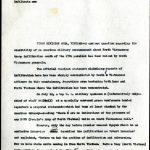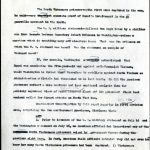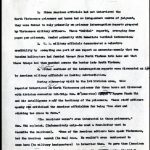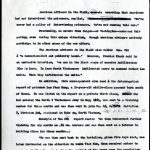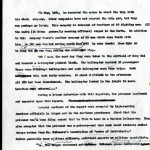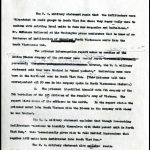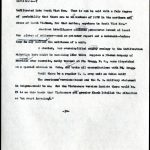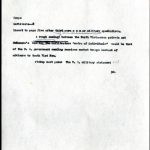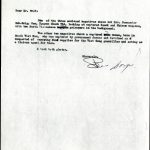1964, August, “North Vietnamese Troop Infiltration”
Beverly Deepe
101 Cong Ly
Saigon
infiltrate one
FIRST DIVISION AREA, VIETNAM–A serious question regarding the credibility of an American military announcement about North Vietnamese troop infiltration south of the 17th parallel has been raised by South Vietnamese generals.
The official American statement minimizing reports of infiltration here has been sharply contradicted by South a Vietnamese officers in this mountainous, 2-province area bordering both Laos and North Vietnam where the infiltration has been concentrated.
On July 14, a top U. S. military spokesma n (informatively only–chief of staff Stillwell) at a specially convened press conference handed reporters a prepared statement–which had been at least checked by the American Embassy–reading “there x are no indications of the presence of any PAVN (People’s Army of North Vietnam) units on South Vietnamese soil.”
However, only the day before Premier General Nguyen Kanh in an exclusive interview sxshix described the infiltration as an “overt invasion” and explained, “Before we had the problem of infiltration and subversion. Now we have whole units coming in from North Vietnam. Before they (nNorth Vietnam) took soldiers from south of the 17th pra parallel and sent them back. Now we find for the first time we caught prisoners who were born in North Vietnam.”
(More)
[deepe?]
[infiltrate 2?]
The North Vietnamese prisoners–the first ones captured in the war, he said–were the first concrete proof of Hanoi‘s involvement in the gu Guerrilla movement in the South.
The U. S. military statement–followed two days later by a similar one from Secreta Defense Secretary Robert McNamara in Washington–raises a question which is troubling many osb observers here: What was the evidence on which the U. S. statement was based? Was the statement an example of “managed news?”
If, for example, Washington xa acknowed acknowledged that Hanoi was escalating the five-year-war against anti-Communist Vietnam, would Washington be forced thard therefore to retaliate against North Vietnam as Administration officials had threatened to do last month. Or did the American statement reflect a more cautious and less emotional analysis than the publicly expriessed views of Prime MinisterPremier Khanh and his generals? Khanh last weekend called for direct attacks on North Viet Nam.
On-the-spot investigation by this repot reporter in Firstthe 1st Division area, comprising the two northernmost provinces, discloses that:
Rex1. Prior to issuance of the U. S. military statement on July 14 and the Washington statement on July 16, no American official had interviewed any of themnrxxkxx North Vietnamese prisoners seized by government forces during the previous eight days. In fact, American field officers conceded they did not evenkno know how many North Vietnamese prisoners had been captured. (A Vietnamese intelligence report listed three; this correspondent saw two.)
fixx (More)
deepe
infiltrate–3
2. Since American officials had not interviewed the North Vietnamese prisoners and hence had no independent source of judgement, they were forced to rely primarily on prisoner interrogation reports prepared by Vietnamese military officers. These “initial” reports, averaging four pages per prisoner, dealed primarily with immediate tactical information.
3. U. S. military officials demonstrated a selective credibility by accepting one part of one report as accurate–namely that two Russian helicopters had ferried troops from North Vietnam into Laos and that these troops had then marched across the border into South Vietnam.
4. But Other sections of the interrogation reports were discounted or ign by American military officials as lacking substantiation.
During a|three-day visit to the 1st Division area, this reporter interviewed on one North Vietnamese prisoner for three hours and discussed with division commander Sub-Brig Gen. X (one-star) Nguyen C Nguyen Chang Thi and his intelligence staff the testimony of the prisoners. These staff officers openly circriticized the American officialdom for being “too slow and sticking too close to form.”
“The Americans weren’t even interested in these prisoners,” Gen. Thi exploded. (Informatively only–he used a four-letter word to describe the Americans). “None of the American advisors here speak Vietnamese, but the American consul (in Hue) does. He wouldn’t even condescend to come here (to military headquarters) to interview them. We gave them (American military adv i advisors) this report,” he said wavigin waving the brief prisoner interrogation report. “Maybe they translated it; maybe the didn’t.”
(More)
deepe
infiltrate–4
American officers in the field, concede conceding that Americans had not interviewed the prisoners, replied, “Wem’mmvmnaksxmingmxhmmm “We’ve never had a policy of interviewing prisoners. We’re not running this war.”
Presumably, no orders from Saigon–or Washington–reversed this policy, even during this unique situation, though American advisors actively participa te in other areas of the war effort.
The American advisors in the field also called Gen Thi a “a sensationalist and publicity hound.” However, Premier Khanh said in an exclusive interview, “we are in the first state of massive infiltration like in Laos. In Laos, North Vietnamese infiltrated cadre to command Pathet Lao units. Then they infiltrated the units.”
In addition, this correspondent also read a the interrogation report of prisoner Lee Phan Hung, a 24-year-old middle-class peasant born south of Hanoi. He was listed in the report as a private first class, Ammxx who had entered the North B Vietnamese army in May, 1963, was sent to a training center for three months and was then sent to join Co. 6x, Battati Battalion 7, Division 324, station in Nghe An, North Vietnam, 220 miles south of Hanoi.
Excerpts of the rea report reads: “he then wunderwent further training for six months on .81 mm mortars and was then sent as a laborer to building dikes for three months . . .
“He was then sent back to the battalion, given five days rest, was later instructed on the situation in South Viet Nam to destroy the control of the enemy over the population. He was well fed over the five days in preparation for the trip South and was promoted to private first class. (More)
deepe
infiltrate 5
“In May, 1964, he received the order to start the trip with his whole company. Other companies have not started the trip yet, but they may perhaps go later. This company is composed of draftees of 90 fighting men. All the cadre (Ed note: generally meaning officers) stayed in the North. In addition to this company there’s another company of 90 men which came South with his. So 180 men started moving south May 1964 by nine trucks from Nghe An to Dong Hoi3 [momies?] South of Hanoi in one day, making one overnight stop.
“At 6 a.m. the next day they were taken to the airfield of Dong Hoi and boarded a helicopter painted black. The helicopter carried 20 passengers There were 2 helicop t two helicopters and each helicopter made fourfive trips. Each xhelixixcoptxerxx trip took forty minutes. At about 2 o’clock in the afternoon all 180 had been transferred. The helicopter landed in the jungle in Laos. Location unko unknown. …”
During a 3-hour interview with this reporter, the prisoner confirmed and expanded upon this report. Thexreportxmakesxmexxmxx
Several sections of the report were accepted by high-ranking American officials in Saigon and in the northern provinces: first that the prisoner was a bona fide; second that he flew to Laos in a Russian helicopter. They also accepted that the prisoner was a private–and that rank would indicate combat troops rather than Mr. McNamara’s description of “cadre of individuals.”
1. The SaigonU. S. Military statement and McNamaa McNamara press conference ignore> SHARPLY Contradict these fundamental parts of the report:
1. The prisoner said he came to Vietnam with hiws own 90-man company along with another 90-man company. (More)
deepe
infiltrate–6
The U. S. military statement reads that the infiltrators were “dispatched in small groups to South Viet Nam where they repor–tedly were to combine with existing local units to form new companies and battalions.” Mr. McNamara indicated at his Washington press conference that he knew of no instances of infiltration of organized North Vietnamese units into the South Vietnamese war. xxxorganizingxxx
The prisoner interrogation report makes no mention of the Whether or not the entire 90-man company of the prisoner were was composed of North Vietnamese personell personnel; Born in North Vietnam. thempirsmmpsrisonmmpriosonermm hHowever, the U. S. military statement said they were trained in “mixed packets,” indicating some were born in the North Vietnam and some in South Viet Nam. (ThisThe prisoner told this correspondent all 90 men in his company spoke in North Vietnamese dialect.)
2. The prisoner identified himself with 6th company of the 7th battalion of the 3254 division of the People’s Army of Vietnam. The report lists names of its officers in the north. In the report states the prisoner moved into South Vietnam with the 90-men in the company with whoms he was trained.
The U. S. military statement explains that though low-ranking infiltrators “continue to identify themselves with their parent unit in North Viet Nam,” this “occasionally gives rise to false initial impressions that regular PAVN units have infiltrated into South Viet Nam.”
The U. S. military statement also explains reads: “As far as can be determined, all former members of PAVN units and groups of men drawn from PAVN unitsseveralSEVER connections with their former units once they have(MORE) –>
deepe
infiltrate–7
infiltrated into South Viet Nam. Thus ist can be said with a fair degree of probability that there are no mo members of PAVN in the northern ara areas of South Vietnam, for that matter, anywhere in South Viet Nam.”
American intelligence officxxx procedures demand at least two pieces of evidence–such as prisoner report and a document–before they dm may confirmconfirmingthe existence of a unit.
A similar, but oversimplified analoy analogy to the infiltration situation here might be something like this: suppose a 90-man company of AmericanU. S. Army recruits, newly trained at Ft. Bragg, N. C., were dispatched on a special mission to Cuba, andBUT broke all communications with Ft. Bragg.
Would there be a regular U. S. army unit on Cuban soil?
The Americans version–based one the U. S. military statement in Saigon–would be no. But the Vietnamese version insists there would be. It is on this basis that Vietnamese pri premier Khanh labelled the situation as “an overt invasions.”
-30-
deepe
infiltrate–8
insert to page five after third para x x x or military specialists.
A rough analogy of the difference between the North Vietnamese private and McNamara’s calling the infiltrators “cadre of individuals” would be that of the U. S. government sending American combat troops instead of advisors to South Viet Nam.
Pickup next para: The U. S. military statement xxx
30-
Dear Mr. Wald:
One of the three enclosed negatives shows 1st Div. Commander Sub.-Brig Gen. Nguyen Chan Thi, looking at captured Czech and Chicom weapons, with two North Vietnamese ixmpxx prisoners in the background.
The other two negatives shows a captured wxoxwoman, born in South Viet Nam, who was captured by government forces and detained as a suspected of carrying fooxd supplies for the Viet Cong guerrillas and acting as a liaison agent for them.
I took both photos.
Sincerely,
Read Previous Article: 1964, July, “General Nguyen Khanh”
Read Next Article: 1964, September, “Astrologers and Fortunetellers in this Year of the Dragon”

